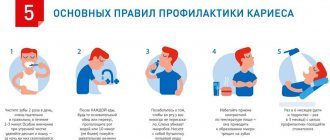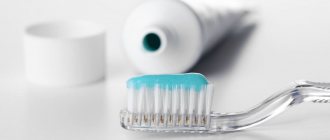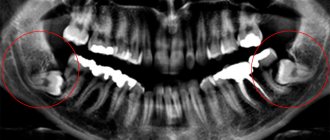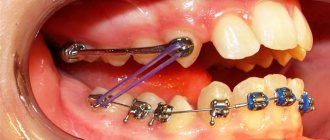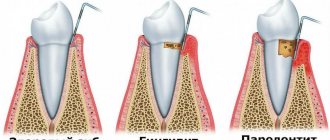What happens to teeth due to smoking?
So, what happens to the teeth of a heavy smoker?
Cigarette smoke passes through the oral cavity twice, on inhalation and exhalation, and interacts with tooth enamel for a long time. During this interaction, plant resins from tobacco leaves are absorbed into plaque, giving it an unpleasant yellow tint. Over time, plaque becomes more durable and turns into tartar deposits that are difficult to clean off. Coloring substances turn the entire surface layer of tooth enamel yellow, which leads to its increased fragility and susceptibility to carious lesions. Caries develops on many teeth at once. If a person continues to smoke, carious lesions grow and can lead to tooth loss. In addition, cigarette smoke damages the gums, leading to periodontitis, periodontal disease, and gingivitis, as a result of which teeth begin to loosen in weakened tissues.
Due to vascular disorders, the salivary glands work worse and secrete less resin containing lysozyme, which fights microorganisms in the oral cavity and prevents the proliferation of carious bacteria. You can visually see how smoking negatively affects tooth enamel in the photo, which compares the teeth of a healthy person and a smoker.
Lips
If you have been smoking for many years, then you are almost certainly familiar with the problem of dry lips. The thing is that smokers produce less saliva (the body refuses to perceive a cigarette as something edible), so a person experiences a feeling of dryness and involuntarily licks his lips. At the same time, they lose their protective water-fat film and instantly become weathered in the air. As a result, inflammation of the red border of the lips develops - cheilitis.
Your actions. Use a special moisturizing lipstick with medicinal ingredients, such as cocoa butter, almond oil, and chamomile extract. You can also lubricate your skin with a softening baby cream with vitamins A and E before going to bed.
It is also worth paying attention to toothpaste - sometimes it worsens the condition of the lips. Pastes containing fluoride are especially aggressive on the skin and can cause persistent irritation. Give them up for a while and choose pastes with herbal anti-inflammatory ingredients.
The effect of smoking on teeth - the main causes of pain
The destructive effect on a smoker's teeth is due to several factors. The first thing worth noting is the powerful effects of toxic substances from cigarettes. Enamel deteriorates due to the presence of the following components:
- hydrocyanic acids,
- carbon monoxide,
- methane,
- resins,
- nicotine.
As a result of contact with these substances, smoking plaque will soon form on the enamel. Gradually, a pathogenic microflora is created in the oral cavity, ideal for the rapid proliferation of harmful bacteria, and then caries is just around the corner. As a result, teeth hurt from smoking and gums bleed. Another destructive factor is the high temperature of the smoke that a person inhales. Such a temperature difference contributes to the appearance of microcracks on the protective enamel surface, and this is a direct path to the proliferation of bacteria and the development of carious processes.
Do-it-yourself whitening
Since it is necessary to constantly visit the dentist to remove plaque, smokers are trying to find ways to whiten their teeth on their own. Methods that can be found on the Internet can be dangerous, but more often they are simply useless:
- Whitening on your own will not remove plaque between your teeth.
- It is impossible to clean the fissures and grooves in the chewing teeth with a toothbrush and improvised means.
- The gingival area of the tooth also cannot be cleaned without dental instruments.
None of the self-whitening methods will remove plaque trapped in microcracks in the enamel.
Professional dental hygiene can help a smoker. The procedure does not whiten the enamel to ideal levels, but it does remove surface pigments. Hygiene is mandatory before the whitening procedure.
Effect of smoking on gums
If we talk about the effects of nicotine and tar on the soft tissues of the oral cavity, then a bad habit can lead to the development of inflammatory processes. The gum tissue becomes looser, gradually turns red, and irritation appears. As a result, sooner or later bleeding occurs, which can also cause pain. In addition, cigarettes disrupt the blood supply to soft tissues. Gradually, the gums begin to atrophy, “lag behind” the surface of the teeth, which leads to their mobility and even loss. Of course, all this does not happen in one day. The process is long and therefore not so obvious, but to stop it, you will have to give up cigarettes.
Effect on tissue regeneration
Tobacco smoke slows down tissue healing.
Is it possible to smoke after tooth extraction? This question is asked quite often in dental offices.
The answer is much more obvious and not rhetorical - after treatment of teeth or gums, tobacco smoke will not bring any benefit and will negatively affect wound healing. This is explained by vasospasm, so a decrease in blood in the tissue interferes with its regeneration; in addition, dryness cannot be beneficial for delicate mucous membranes.
Dentists advise refraining from smoking after tooth extraction or gum surgery. Otherwise, the likelihood of developing alveolitis increases.
Tobacco smoke negatively affects the formation of a blood clot that forms at the site of the removed tissue, which protects the bone and nerves from infection by pathogens. If this happens, the patient will complain of severe pain, unpleasant smell and taste in the mouth.
The negative effects of tobacco smoke are reversible, but this takes many years. According to doctors, only after ten years can we talk about reducing the risk of developing cancer to the level of a person who has never smoked.
Smoking and implantation
Unfortunately, such concepts as smoking and dental implants are practically incompatible. Patients who smoke are much more likely to experience implant failure , especially if they smoke during osseointegration.
Smoking several months before the procedure is no less harmful. Much the same can be said about prosthetics – it is much more difficult for smoking patients to adapt to wearing prostheses, and they often experience complications and side effects.
IMPORTANT: Unfortunately, concepts such as smoking and dental implants are practically incompatible. Patients who smoke are much more likely to experience implant failure, especially if they smoke during osseointegration.
Smoking and tooth extraction
The question of how safe it is to smoke after tooth extraction worries many smokers. The procedure itself is associated with a certain amount of stress, and therefore many patients involuntarily have the urge to smoke a cigarette after visiting the dentist’s office. It is believed that this way you can get a certain calming effect. However, it is still better to refrain from this ritual, because nicotine and tar can have an irritating effect on an open wound. Otherwise, there is a risk of bleeding and pain. In addition, tobacco smoke slows down the healing process.
Important! After wisdom tooth removal, all precautions must be observed especially strictly. Often, such an operation is complicated by an overly branched and tangled root system, which the doctor is forced to remove in stages. If you smoke, be sure to tell your dentist this, and at the same time clarify how long after removal you can smoke a cigarette.
The patient will have to be patient and wait at least 2 hours after the procedure. It is important to wait until the bleeding stops completely. Another unpleasant consequence can be the so-called dry socket, while the presence of a protective blood clot in it is an extremely important condition for preventing wound infection.
Only numbers
- 75% of men and 21% of women in Russia smoke constantly.
- 1-2 packs of cigarettes contain a lethal dose of nicotine. The only thing that saves the smoker is that this dose is not introduced into the body immediately, but in parts.
- The average smoker takes 200 puffs a day. Each time he inhales more than 30 toxic chemical compounds. 25% of regular cigarette smokers will die prematurely due to smoking.
- After 3 months of smoking, a person becomes dependent on tobacco. In women, tobacco addiction develops more rapidly than in men.
Alternatives to cigarettes that cause less harm
Thanks to steadily developing technologies, smokers today have a chance to make their addiction less dangerous and protect their oral cavity. For this purpose, various alternative means , for example:
- Electronic cigarettes - in some ways, the principle of operation of an electronic cigarette is similar to an inhaler. This device has a shape similar to the usual cigarettes and creates the illusion that a person is using a regular tobacco product. An electronic cigarette includes a battery, LED indicator, vapor generator, replaceable cartridge and other components.
- Hookah is equipment for smoking hookah mixtures and consists of a shaft, a flask (water is poured into it) and a cup (the smoking mixture is poured into it). Essentially, a person inhales aromatic smoke and thereby satisfies his habit.
- Patches create optimal conditions for the intake of purified nicotine into the body, which helps satisfy the daily need for smoking.
- POD systems are compact electronic cigarettes with a small battery, which are a disposable item. Very convenient to use.
- Sprays are recommended during the period of quitting an addiction; their principle of action is similar to nicotine patches. But in both cases, the nicotine component is used as replacement therapy (to prevent the development of withdrawal syndrome). Suitable for experienced smokers. Sprays are available both nasally and orally.
Sources:
- https://telo.guru/kurenie/vred/izmeneniya/zuby-kurilshhika.html
- https://MikDent.ru/estetika/uhod/kurenie-i-zuby.html
- https://mnogozubov.ru/kurenie-vliyanie-na-zuby/
- https://Denta.help/terapevticheskaya/nekarioznye/zuby-kurilshhika-1313
- https://stom.32top.ru/stat/1877/
- https://dentamed.club/gigiena/profilaktika/zuby-kurilshhika.html
Ways to get rid of plaque
Some smokers believe that it is impossible to get rid of the yellow tint of teeth. This is wrong. It is quite possible to whiten yellowed enamel, and you can even try to do it at home. However, if the case is advanced, and the plaque has turned from yellowish to brown or even black, then folk remedies are likely to be ineffective. A dentist will help you thoroughly clean your teeth from old pigmentation.
Home whitening methods
When choosing methods for getting rid of plaque, you need to understand that home procedures will take much more time than professional cleaning at the dentist.
To remove plaque at home, you can use the following methods:
- Using baking soda. The abrasive properties of this substance allow you to effectively remove plaque and polish tooth enamel. To achieve results, you can use baking soda in its pure form or add it to your usual toothpaste. You can use this method no more than twice a week.
- Lemon peel. Rubbing the surface of the teeth with the crust of this fruit helps lighten the enamel.
- Cleaning with activated carbon. Crushed charcoal is applied to the brush and the teeth are cleaned with gentle movements. The method is highly effective, however, the efforts made should be controlled to avoid damage to the enamel.
- Using tea tree oil. This product is distinguished by its safety and has an additional antibacterial effect. After cleansing your teeth with regular toothpaste, apply a few drops of oil to your brush and gently brush your teeth again. Then rinse your mouth with water and a few drops of lemon. After the procedure, you may feel a slight numbness.
- Hydrogen peroxide. A few drops of peroxide solution are applied to a cotton swab and wiped over the teeth. After this, you need to perform hygiene with toothpaste and then rinse your mouth thoroughly. Peroxide has a pronounced effect, but has an adverse effect on the enamel.
- Factory products. Effective is the use of various whitening gels applied to the teeth using a special tray. Lightening agents in the form of strips have a similar effect. When using these devices, you must be careful and strictly follow the instructions in the instructions.
In order to avoid plaque caused by a bad habit, you need to brush your teeth after every cigarette you smoke. Unfortunately, this opportunity does not always exist. Regular use of home whitening methods will help get rid of fresh plaque and prevent it from acquiring a dark shade.
Attention! In addition to the above methods, it would be useful to include solid vegetables and some types of fruits in your diet, which help clean and brighten your teeth. These include: strawberries, apples, lemons, celery and carrots.
Features of whitening with soda
When wondering how to remove plaque on teeth after smoking, many people opt for baking soda.
The method is really effective, although there are contraindications, such as:
- tendency to bleeding gums;
- increased sensitivity of enamel;
- enamel pathologies (fluorosis, hypoplasia);
- carious infections.
If the listed contraindications are absent, you can try this type of whitening. Procedure steps:
- Prepare soda in the form of a dry powder or a paste-like mixture with water. You will also need a toothbrush.
- Baking soda must be applied to the toothbrush (if using dry powder, the brush must be moistened with water).
- Brush your teeth, being careful and trying not to get it on the oral mucosa.
- Rinse your teeth thoroughly.
This method should not be used more than twice a week. Baking soda can be used not in its pure form, but added to regular toothpaste.
Professional teeth cleaning after smoking
Advanced forms of plaque on teeth are best left to the dentist. A professional approach to lightening enamel after smoking includes two types of procedures:
- Professional hygiene. The procedure is carried out using soft abrasive cleaning and ultrasonic methods. During the manipulation process, teeth are even removed from old plaque and tartar.
- Enamel whitening. This method is used when the natural color of the teeth is not satisfactory, and the patient wants to have a perfectly snow-white smile.
Sometimes combined methods are used, combining them with subsequent remineralization of tooth enamel.
